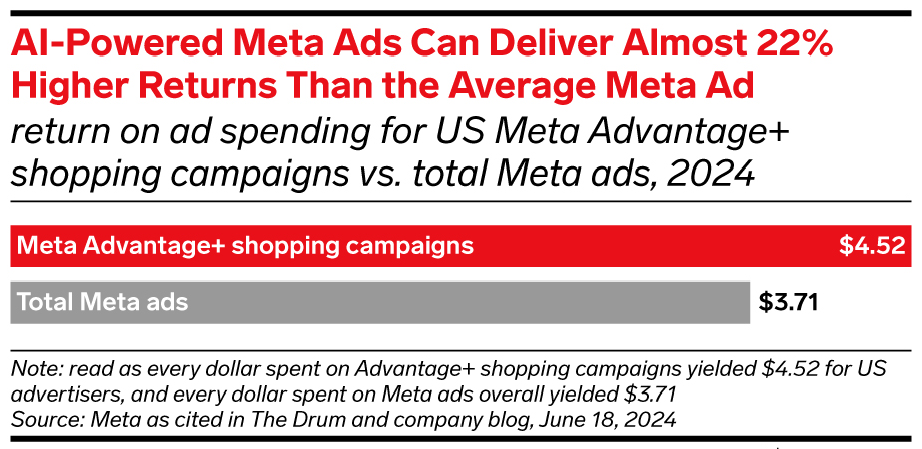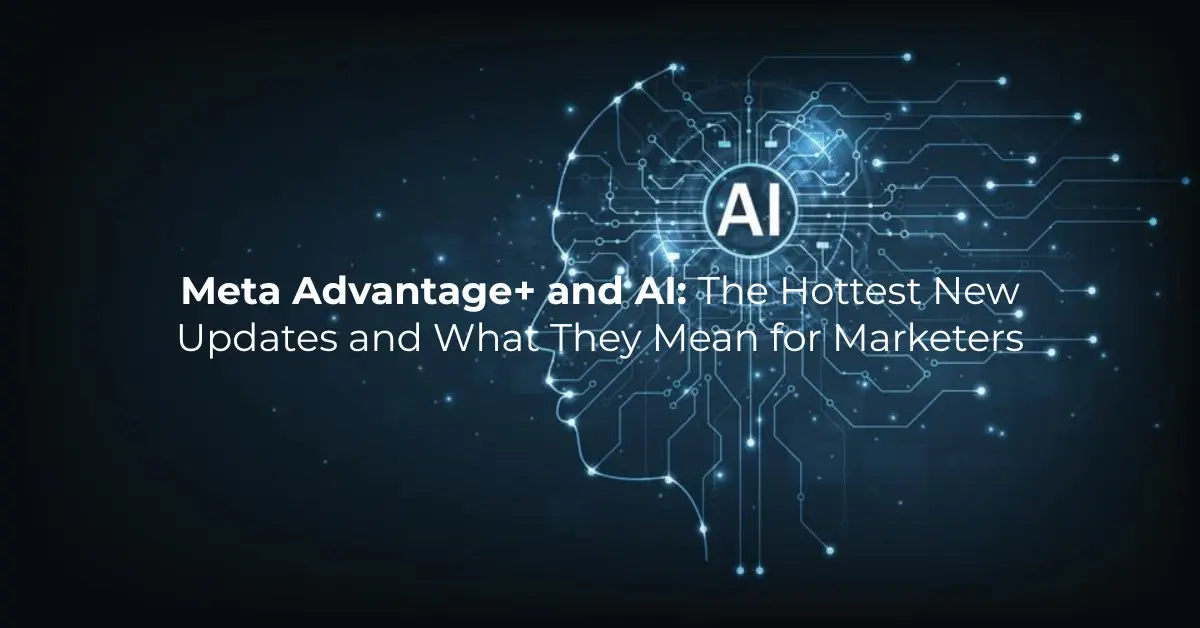
Meta Advantage+ and AI: The Hottest New Updates and What They Mean for Marketers
Meta Advantage+ AI Advertising Updates 2025 are changing how agencies and small businesses run ads on Facebook and Instagram. With new AI tools, better targeting, and smart creative options, Meta is making advertising faster and easier. This article explains how these updates boost results and simplify campaign management for marketers.
The Latest Meta Advantage+ and AI Updates
Meta’s latest updates expand Advantage+ automation to more campaign types. They also enhance creative tools, improve targeting with machine learning, and add new performance tracking features. Here are the hottest updates you should know about:
Advantage+ Expands to Lead Generation and Sales Campaigns
A key update is that Advantage+ campaigns now support lead generation, not just online sales. Meta has expanded its AI automation to help advertisers get more leads, similar to how it boosts e-commerce results. When creating a Leads campaign in Meta Ads Manager, advertisers can turn on Advantage+ with an easy setup. It includes Advantage+ placements, Advantage+ audience, and budget optimization. Once active, Meta’s AI adjusts targeting, delivery, and budgets automatically. Early results show lower costs per lead as the system finds people more likely to convert.
Meta has renamed Advantage+ Shopping Campaigns to Advantage+ Sales Campaigns to cover more than just shopping goals. With the new version, advertisers get more flexibility and control. They can now add or exclude custom audiences and set simple audience preferences, such as age or gender. These options were missing in the old automated setup.
Meta also removed the one-ad-set limit. Now, an Advantage+ Sales campaign can include several ad sets, each with up to 50 ads. The old version allowed only one ad set with 150 ads total. These updates give marketers more control and better ways to organize campaigns while keeping automation. The manual vs. automated setup switch is also gone. New sales campaigns start in the simplified Advantage+ format, and advertisers can adjust settings as needed.
Streamlined Campaign Setup and New Optimization Scores
Meta’s Ads Manager is increasingly guiding advertisers toward best practices with streamlined setup and new performance scores. When you create a campaign for sales, leads, or app installs, Ads Manager may show a “Campaign Score.” This score (0–100) reflects how closely your setup follows Meta’s recommended best practices. It considers things like your budget strategy, audience settings, and use of Advantage+ automation. A higher score means your campaign structure aligns with Meta’s AI guidance. However, Meta notes it is not a results guarantee, just a quality measure.
When your campaign goes live, a new Opportunity Score will be available to more advertisers. This score ranges from 0 to 100 and shows how many of Meta’s suggested improvements you’ve applied. It also gives real-time AI tips, for example, “turn on Advantage+ placements” or fix an ad format issue.
In early tests, advertisers who followed these AI recommendations saw an average 5% drop in cost per result. The gain may seem small, but every improvement matters in a competitive ad market. These scores work like a quick health check, showing how well you’re using Meta’s AI tools. Meta also encourages advertisers to enable Advantage+ features and fix issues the system detects, such as an ad not being formatted correctly for a placement.
Meta Advantage+ Creative: AI That Reinvents Ad Creation
One of the most exciting innovations from Meta is its generative AI creative technology, built into the Advantage+ Creative suite. This tool also allows advertisers to generate multiple ad versions automatically. It tailors visuals, text, and layouts for different audiences and placements.
With one uploaded image or video, Meta’s AI can create variations changing backgrounds, adjusting aspect ratios, adding effects, or rewriting ad copy. These enhancements help brands quickly test what works best and optimize engagement in real time. Meta reports that advertisers using AI-generated creatives have achieved up to 11% higher click-through rates compared to traditional ads.
Since its launch, Advantage+ Creative has become a key part of Meta’s advertising ecosystem. In 2024 alone, more than 15 million ads were created using Meta’s AI tools by over a million advertisers worldwide.Features such as Background Image Generation and Full Image Generation transform static visuals into dynamic, audience-focused versions. New AI video tools can turn still images into short animated clips automatically.

Meta has added brand consistency controls, allowing advertisers to upload logos, colors, and fonts. The AI then keeps a unified look across all variations. Additional features like AI-generated music and voice dubbing make it easier for businesses to create localized, multilingual campaigns.
In essence, Advantage+ Creative acts as a digital creative director producing, testing, and refining ads faster than ever. For agencies and SMBs, it means less manual work, faster turnaround, and more impactful campaigns tailored to every audience segment. Meta’s evolving AI suite is redefining what’s possible in ad creation making creativity both smarter and more scalable.
Smarter Targeting with Predictive AI and Advantage+ Audience
Meta is transforming ad targeting with Predictive AI through its Advantage+ Audience tool. Instead of relying on static demographics or manual filters, Meta’s AI now identifies the highest-intent users in real time. The system analyzes billions of behavioral signals to predict which users are most likely to act. It then serves ads directly to them.
This marks a shift from traditional targeting methods such as lookalike audiences or interest-based segments. Meta’s engineers emphasize that creative diversity now drives better performance than narrow targeting. By testing many ad variations, AI matches each creative with the right audience, uncovering new customers marketers might otherwise miss.
Behind this innovation is Andromeda, Meta’s advanced AI retrieval engine. It improves how ads are selected and ranked for every user. Early results show a 6% increase in recall and 8% higher ad quality, proving better engagement.
For advertisers, this means less time spent on manual research and segmentation. Advantage+ campaigns automatically manage budgets, bids, and placements across Meta platforms, optimizing conversions across Facebook and Instagram. Meta’s internal data shows that advertisers using AI-driven targeting achieved up to 22% higher ROAS than manual setups.
Meta is also expanding how and where ads appear. New ad placements include notifications tab ads, AI-powered virtual try-ons, and omnichannel Advantage+ campaigns that optimize both online and in-store sales. Brands using these tools report 15% lower CPA and 12% higher ROAS.
In short, Predictive AI and Advantage+ Audience mark a new era of smart advertising, where machine learning adapts, personalizes, and delivers ads with precision.
Improved Performance Measurement and Attribution Tools
A major update is the Opportunity Score, which shows how well a campaign follows Meta’s best practices. The score ranges from 0 to 100 and gives personalized AI tips, such as turning on Advantage+ placements or fixing ad setup issues. Advertisers who followed these suggestions saw an average 5% drop in cost per result, proving that AI guidance can improve performance.
Meta also launched Incremental Attribution, a tool that uses machine learning to measure more than just last-click results. Instead of crediting only the final action, it also includes upper-funnel and view-through conversions that older tracking systems often miss. This helps marketers see the true lift their campaigns create, especially important with today’s privacy limits and data loss.
To build trust in these tools, Meta released new performance data. For every $1 spent on AI-powered Advantage+ campaigns, advertisers earned about $4.52 in revenue, a 22% higher return than standard campaigns. An eMarketer study found similar results, showing AI-driven ads perform 20–22% better than manual ones. Advertisers also reported a 9% lower cost per action with the new Advantage+ Sales setup.
Together, these updates show Meta’s focus on data-driven clarity in AI advertising. With automation and transparent tools like Opportunity Score and Incremental Attribution, marketers can measure success more accurately and get the most value from every dollar spent.

Meta GEM: AI for Smarter Optimization
Meta’s continuous backend upgrades are further strengthening ad performance. A key innovation is Meta GEM (Generative Empirical Optimization Model). This AI system refines ad recommendations and budget allocation. It analyzes campaign data in real time and identifies where spending delivers the best results. GEM improves conversion rates by up to 5% through smarter learning.
These advancements from better conversion modeling to AI-based insights, help advertisers trust automation more. With GEM and other AI systems powering Advantage+ campaigns, marketers gain clearer feedback and stronger optimization. Every decision becomes more efficient and contributes to measurable growth.
Strategic Impact on Campaign Management
The rise of Meta Advantage+ AI advertising tools is changing how marketers manage campaigns. Tasks like targeting, budgeting, and bidding are now automated. This shift moves marketers from doing manual work to focusing on strategy. Campaign managers spend less time on settings and more time defining goals, budgets, and creative direction while AI handles optimization.
This change doesn’t remove the human role, it reshapes it. Marketers still need to set clear inputs, goals, and limits for the algorithm. In Advantage+ campaigns, humans choose the goal, such as leads or sales, provide creatives, and define exclusions. Meta’s AI then learns and reallocates budget to what performs best. Effective management now means monitoring and guiding, not constant tweaking. Tools like Campaign Score and Opportunity Score help decide when to trust automation or step in manually.
Testing and optimization have also evolved. Instead of running many separate campaigns, advertisers now test within the AI system. They feed it multiple creatives and let the algorithm find top performers. Success depends on clean data, accurate tracking, and enough conversions for the AI to learn well. The goal is to let the AI explore rather than limit it.
For agencies, this shift is especially important. As automation takes over routine work, their value lies in strategy, creativity, and understanding AI insights. Top agencies stand out by creating strong creative frameworks that help AI perform better and by turning data into clear action steps.
In short, campaign management in 2025 depends on teamwork between human intelligence and machine efficiency. Marketers who trust AI to optimize while steering it with strategy will achieve better scale, stability, and results.
Impact on Creative Workflows
The use of AI in Meta’s creative process is changing how marketing teams create and manage ads. For agencies and small businesses, the biggest change is speed. Tasks like resizing images, testing variations, or designing new layouts now take seconds instead of hours.
With Meta Advantage+ Creative, one product photo can turn into many versions with different backgrounds, colors, or layouts ready for every placement on Facebook, Instagram, and Reels. This speeds up creative testing and lets marketers focus more on strategy and less on repetitive design work.
As AI becomes a standard part of creative production, the role of creative teams is evolving. Strategists and designers now act as curators, reviewing AI-generated concepts and guiding them to match brand tone and identity. Meta’s platform lets users preview and adjust AI-created assets before publishing, ensuring that visuals remain consistent with brand standards. Marketers are encouraged to upload brand kits, logos, colors, and fonts, so the algorithm can maintain visual integrity while still innovating.
The payoff is significant: personalized creative drives better engagement. Meta reports that campaigns using AI-driven personalization deliver higher ROI, as the system adapts each creative to specific audience segments. One user might see a product in a minimal, modern style, while another sees it in an adventurous outdoor setting both automatically optimized by AI.
Despite concerns about creative control, a hybrid approach offers balance. Marketers can treat AI output as first drafts, fast ideas to refine and polish manually. Over time, creative workflows will rely on this synergy: AI for speed and scale, humans for insight and emotion. By combining both, agencies can reduce production time by up to half while enhancing storytelling, innovation, and cross-channel coordination.
Impact on Performance Measurement
As Meta Advantage+ AI advertising updates 2025 make campaigns increasingly automated, performance measurement is becoming more complex and more crucial. Marketers can no longer rely solely on detailed manual attribution. Instead, success is now evaluated through aggregate metrics and AI-generated insights.
In automated campaigns, traditional ad set-level comparisons are replaced by broader indicators like ROAS, CPA, Campaign Score, and Opportunity Score. These new tools help marketers understand how well their setups align with Meta’s optimization best practices. For instance, an agency could report, “Our Opportunity Score increased from 75 to 90 after applying Meta’s AI recommendations,” signaling measurable improvement in efficiency.
To measure the real impact of automation, advertisers now use incrementality testing and AI-based attribution. Meta’s Incremental Attribution model gives credit not only for last-click actions but also for view-through and upper-funnel conversions. These are often missed by older tracking systems. This approach gives a clearer picture of performance and shows the full impact of AI optimization. Meta recommends running Conversion Lift and Brand Lift studies to confirm how Advantage+ features help drive growth.
Results so far are promising: AI-powered Meta campaigns deliver an average of 22% higher return on ad spend and reduced costs per result. However, Meta’s “black-box” approach requires a shift in mindset, from micro-analyzing every variable to optimizing the overall system. The key question becomes: Is the AI hitting business goals, and how can we feed it better data or creative inputs?
Finally, performance evaluation now includes how effectively teams use Meta’s AI tools themselves. A strong Opportunity Score demonstrates mastery of the platform, often correlating with lower costs and stronger outcomes. In this new era, success depends on balancing traditional ROI metrics with Meta’s AI-driven performance indicators to gain a complete view of campaign success.
How Agencies and SMBs Can Prepare for These Updates
As Meta Advantage+ AI advertising updates 2025 reshape campaign management, agencies and SMBs must adapt strategically to benefit fully from automation. The key is to start small, learn fast, and build processes that blend human strategy with machine intelligence.
1. Adopt Advantage+ Gradually. Test one Advantage+ campaign, such as Sales or Lead Generation, against your manual setup. Meta reports an average 9% lower cost per action (CPA) with the new format. Use your data to evaluate results and refine settings like budget or audience scope. Gradual implementation helps teams understand how automation behaves before scaling.
2. Feed the AI Quality Data. Meta’s algorithms thrive on accurate signals. Make sure your Pixel or Conversions API tracks every key event, purchases, sign-ups, and leads, so the AI can optimize effectively. Supply a variety of creatives: multiple images, videos, and headlines. The richer your input, the better Meta’s AI performs.
3. Strengthen Creative Skills. Learn how to use Advantage+ Creative tools to preview and control AI-generated ad variations. Upload brand kits with approved colors, logos, and fonts to ensure visual consistency. Agencies can implement hybrid workflows, AI drafts first, designers polish later, for faster, scalable creative production.
4. Monitor and Trust the Process. Give AI campaigns time to learn before making changes. Watch metrics like ROAS, CTR, and Opportunity Score, which reflects how closely your setup follows Meta’s best practices. When the AI suggests optimizations, test them instead of overriding based on instinct.
5. Keep Human Oversight. Define clear goals, budgets, and KPIs. Refresh creatives to prevent fatigue and integrate Meta data with broader analytics across Google or TikTok.
Those who combine automation with strategic thinking will thrive. By adopting Meta’s AI systems early, agencies and SMBs can gain more efficiency, scale faster, and stay competitive in 2025’s digital ad landscape.
Resources worth bookmarking
Want to learn how artificial intelligence is changing the way affiliates work? Check out our post on how AI tools are transforming affiliate marketing. It explores real examples of automation, smarter targeting, and data-driven decisions that boost campaign performance.
Conclusion
The Meta Advantage+ AI advertising updates 2025 mark a major shift toward automation and intelligence. The Advantage+ suite and new generative AI tools now handle tasks once done manually, targeting, creative production, and real-time budget optimization. For agencies and small businesses, these innovations bring clear benefits: higher ROAS and lower CPA. However, they also require a new strategic mindset. Success now depends on how well marketers work with Meta’s AI. They must provide quality data, follow AI insights, and focus on creativity and strategy where humans add the most value.
Every aspect of campaign management is evolving. AI handles execution, allowing marketers to focus on planning, analysis, and cross-channel integration. Creative workflows are faster and more adaptive, powered by generative tools that produce multiple ad variants while maintaining brand integrity. Performance measurement is expanding beyond traditional KPIs, incorporating AI-driven metrics like Opportunity and Campaign Scores to gauge optimization quality.
For smaller advertisers, automation levels the playing field, enabling access to advanced optimization once reserved for large teams. For agencies, it’s a wake-up call to evolve from operational execution toward strategic partnership and creative innovation.
Ultimately, Meta’s AI ecosystem rewards those who work with it, not against it. By experimenting, staying informed about new releases, and developing in-house AI literacy, marketers can future-proof their performance. The winning formula in 2025 is clear: human insight combined with AI precision. Those who master this balance will not only achieve stronger results but also redefine what’s possible in digital advertising.
